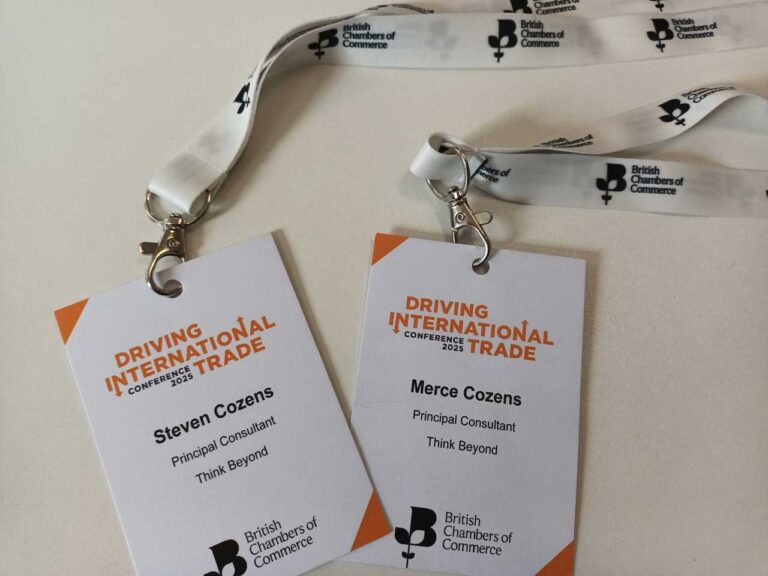After attending the Driving International Trade Conference 2025 on Thursday 20th March, we wanted to summarise some of our thoughts. One highlight was that only 10% of British businesses export. However, according to the British Chambers of Commerce – organisers of the event – nearly 40% of their members export. Across 50 Chambers and 70 British Chambers outside of the UK, there is a great support network there for export procedures and contacts. But, what about the business rationale for exports? Does it make sense? Are you exporting to the right markets? Do cultural differences hinder commerce? Are we competitive against China? Where do SMEs fit into the international trade jigsaw puzzle? Today, we discuss driving international exports for business resilience.
Driving international exports
There are many interdependencies to driving international exports, once a business has decided that it is the right thing for them. A company that is new to exporting has a steep learning curve. A company that exports a little bit to a lot of countries has much paperwork to do and regulations to follow. When the majority of your business involves exporting, complexity is a common bedfellow and risk management becomes an obsession.
Here are some possible ways to drive international exports (in no particular order):
- Research;
- Free-Trade Agreements;
- Stable political, economic, social, technological, legal and environmental factors;
- Business incentives;
- Competitive tax regime;
- Diplomacy and cultural awareness;
- Export and trade finance;
- A clear industrial strategy;
Stable, predictable and open trade relationship help everyone to export more. Free Trade Agreements (FTAs) speed up the flow of goods and services between economies, reducing customs red tape and removing tariffs. Similarly, access to export and trade finance arrangements help to manage the cashflow aspects of exporting. Whether you need to build larger facilities, buy equipment or wait to be paid, all put strains on cashflow.
Crucially, the UK’s services economy accounts for over 80% of our exports. It is tempting to focus solely on goods, which we can see moving on roads, trains, ships and aircraft. Additionally, SMEs comprise over 60% of employment and over 99% of businesses. They need stability, support and seamless trade arrangements the most. The truth is that all require focus and support from ministers, Chambers, ambassadors and institutions alike.
Challenges in international exports
The backdrop to exporting is complex. Assuming that you have your own house in order and that you have squeezed the most that you can from your domestic market, it’s time to look farther afield. In summary, it is not all calm seas and clear skies out there. Against the backdrop of lacklustre growth, possibly 1% this year, we need to dial up international exports. Additionally, with tariffs and geopolitics, Brexit trade arrangements, energy prices, high interest rates (relatively) and persistent inflation, it still has to make a return on investment.
Without sounding too much like a stuck record, businesses want stability. Protests in Turkey, tariffs from the USA and wars in Ukraine and the Middle East tend to scare off investment inflows. Additionally, high inflation, such as in Argentina and Turkey, as well as ‘grey finance’ countries such as Croatia, Cuba, South Africa and Venezuela, are higher risk for investment. The importance of stable financial, political, judicial and regulatory regimes is crucial.
The elephant in the room is price competition from China. In some cases, innovation, intellectual property, quality and certifications may trump price competition. In other cases, UK businesses compete against subsidies for Chinese industries, lower labour costs, cheaper raw materials and brand-new facilities. Eventually, Chinese manufacturing output that is cheap to import today may not be cheap in 10 years’ time when their international competitors have gone out of business. Do we really want that?
Driving business resilience
The drawbacks are often outweighed by the benefits. It is common knowledge that exporters faired better after COVID than non-exporters. Exporters tend to record higher profits and pay higher salaries. In general, businesses with exposure to other markets are more resilient to changes in their domestic market. Finally, they are more productive, delivering more revenue per head than non-exporters. With the increased cultural awareness, more robust supply chains and reliance on many markets rather than one, businesses often thrive. Presence in multiple markets is less risky than sole reliance on your home territory. Sure, you may occasionally see a ‘blip’ or have to exit a market completely. However, if you only have one market then that means pulling down the shutters and handing back the keys.
Driving international business
Think Beyond works with companies that operate in one market or many markets. For those thinking of exporting because growth has stalled, we can look internally to unlock performance or support your export strategy. For those already exporting to a few countries, we can help you to streamline your approach and analyse the optimum markets for you. Furthermore, if you are thinking of exporting but don’t want to cede too much control, we can scope targets for acquisition in certain markets (please ask for more information).
If you would like to arrange a free initial consultation, please check out our website for more information. Alternatively, you can email us directly at sales@think-beyond.co.uk.
Finally, why not read a related article on productivity and exports, another on overseas market expansion or the importance of cultural codes.

